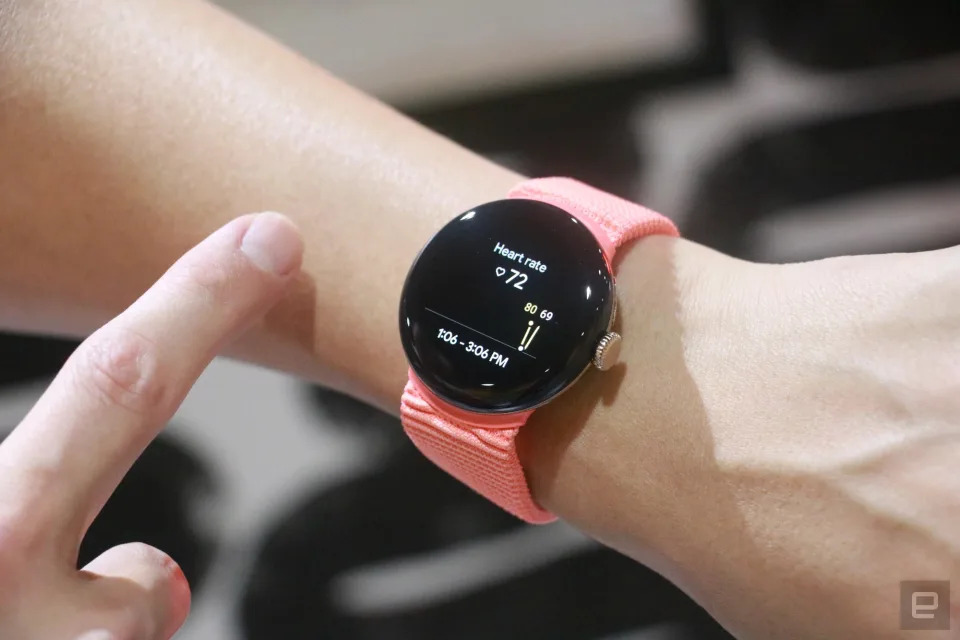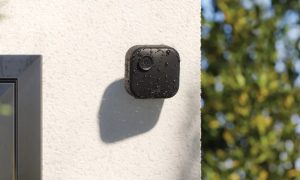When Google introduced the original Pixel Watch last year, there were high expectations that it could compete head-to-head with the Apple Watch. Unfortunately, due to issues like subpar battery life and challenges integrating Fitbit’s health-tracking capabilities, Google fell short of delivering a truly satisfying competitor. As a result, the anticipation surrounding the Pixel Watch 2 is considerably lower than its predecessor, and Google needs to make a compelling case for why users should consider upgrading.
Externally, the Pixel Watch 2 introduces a relatively modest set of updates. However, it brings forth some compelling new features that have the potential to establish it as one of the top choices for health and wellness tracking wearables. Priced starting at $350, the Pixel Watch 2 falls between the $300 Galaxy Watch 6 and the Galaxy Watch 6 Classic, as well as the $400 Apple Watch Series 9. It incorporates a multi-path heart rate monitor, introduces body-response and skin temperature sensors, and introduces new applications and personal safety features that both differentiate it from the competition and bring it up to par.
Many of the forthcoming changes in the new Pixel Watch are not easily assessable during a brief hands-on session. This includes the new body-response tracking tools and the improved accuracy of the multi-path heart rate sensor. Additionally, it’s challenging to predict whether the added Safety Check feature will genuinely provide peace of mind when venturing into unfamiliar places alone.
One thing I quickly noticed is that, at first glance, the new Pixel Watch retains its attractive design. The rounded face and domed glass maintain their smooth and sleek appearance. Google mentions that it has managed to reduce the weight of the case by a noticeable 5 grams, and the glass covering the screen is slightly thinner. The company also claims that the recycled aluminum housing enhances the tactile feedback from the rotating crown, even though the vibrating motor remains the same.
The reduction in weight should contribute to a more comfortable wearing experience, particularly if you intend to keep the watch on while sleeping. When I tried it on, I didn’t notice a significant difference in weight, but it’s likely that most people would have a hard time discerning a mere 5-gram variation.
Crucially, Google has mentioned that it redesigned the back housing to accommodate the three new sensors and ensure consistent contact with the skin. This design adjustment also helps keep the heart rate monitor securely in place during vigorous activities, ensuring more reliable measurements. Typically, when I hear about such watch case designs, I worry about them being uncomfortably snug, but the Pixel Watch 2 I tried on felt comfortable. Just like last year, I found Google’s woven loop band to be exceptionally comfortable on my wrist, akin to wearing a scrunchie.
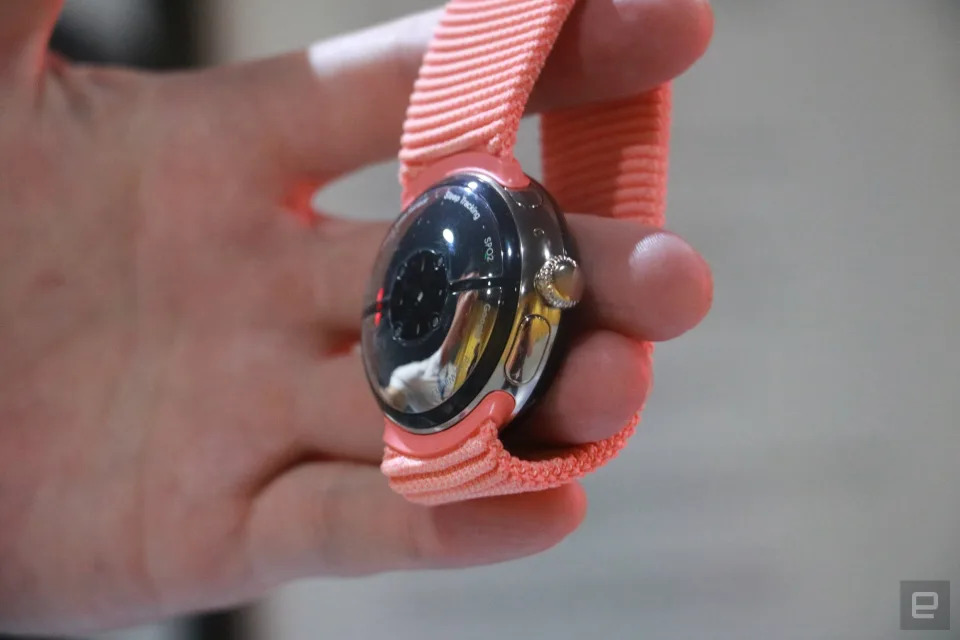
Regarding accessories, Google is introducing some new options, including a lighter perforated sports band and a slim strap made of metallic links. Swapping these accessories remains straightforward, thanks to Google’s proprietary push-and-click mechanism, which has been likened to changing lenses on a DSLR camera. Additionally, new watch faces are being introduced, resembling those recently launched by Apple for its smartwatches. These faces position information at the far edges of the screen, creating the illusion that it’s right on the bezels.
The Pixel Watch 2 maintains its single size option (41mm), and its AMOLED screen boasts the same 320 ppi pixel density as its predecessor. It also reaches the same impressive brightness of 1,000 nits. However, Google has made adjustments to font size and color schemes, particularly in apps like the workout app, to enhance readability. Personally, I’ve had no issues with viewing my activity stats on the Pixel Watch, and the 41mm size fits comfortably on my relatively small wrist. Still, there may be individuals who prefer a larger screen.
Google also mentions that animations appear smoother on the Pixel Watch 2, thanks to its quad-core Snapdragon Wear 5100 processor. This chip offers more cores than the Exynos 9110 found in the original watch and employs a more power-efficient 4nm design, in contrast to the Exynos’ 10nm process. These improvements, along with a slightly larger 306mAh battery (up from 294mAh in the previous model), should result in extended battery life.
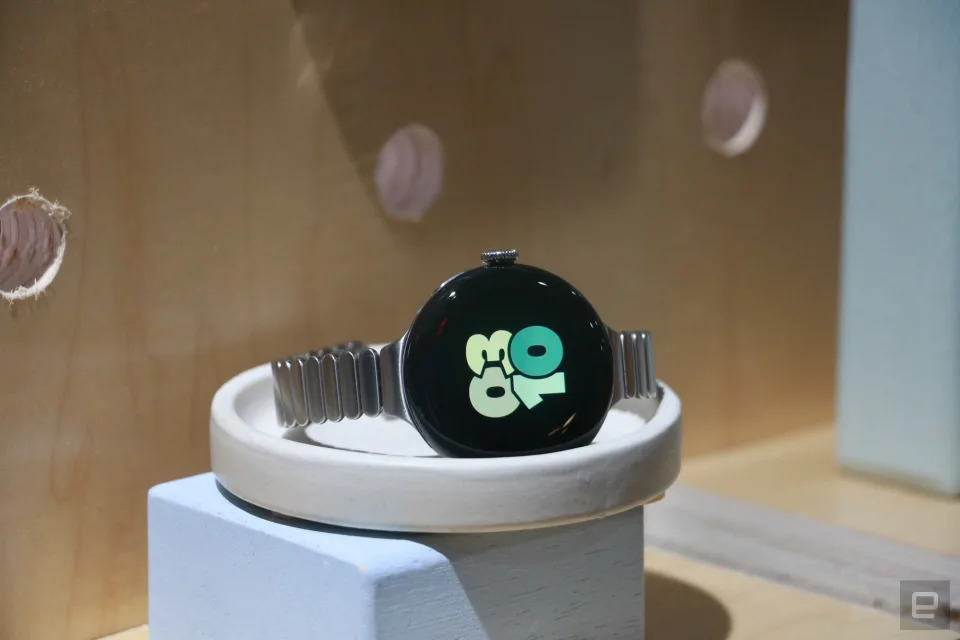
However, the Pixel Watch 2 ships with its always-on display (AOD) enabled by default, resulting in a listed battery life of the same 24 hours as last year when the number was provided with the AOD turned off. It’s reasonable to assume that disabling the AOD might yield a few additional hours of usage, but I cannot confirm this without personally testing the device. Google has also introduced a new contact charging design on the underside, claiming it can provide 12 hours of power after just 30 minutes of charging, with a full charge taking 75 minutes. Regrettably, there is no support for wireless charging, which appears to be a notable omission.
Accompanying the updated contact charging feature are a multitude of sensors. The body response sensor, functioning as a continuous electrodermal activity (cEDA) monitor, detects tiny sweat beads. By leveraging data from this sensor, along with the skin temperature sensor, pulse, and heart rate variability, the Pixel Watch 2 can make educated guesses about your stress levels. It may suggest actions such as logging your emotions, trying guided meditation, or going for a walk.
Google (or more accurately, Fitbit) has previously offered similar stress management features, having introduced an EDA sensor on its Sense smartwatch in 2020. While the company has gained some experience in tracking this metric over the years, it remains an evolving field. During my brief time with the demo unit, I didn’t wear it long enough for it to register any stress, even though I was undoubtedly feeling it. Consequently, I couldn’t explore the suggested actions. Nevertheless, I’m intrigued by the potential insights that extended real-world usage might reveal over time.

I’m also eager to put the new heart rate sensor through its paces during my daily HIIT workouts. However, what truly excites me is a feature that should have been present in the Pixel Watch from the outset: automatic workout initiation and cessation reminders. In fact, this was one of my criticisms of last year’s model, and I’ll quote my review to illustrate:
“Additionally, while Samsung and Apple send alerts when they notice you’ve been walking or exercising for an extended period, the Pixel Watch remains silent. In fact, I thought it wasn’t detecting my brisk mile, and I started to get quite frustrated. It wasn’t until much later when the walk appeared in the Fitbit app that I realized it had indeed counted my activity.”
With the Pixel Watch 2, you’ll receive gentle reminders after engaging in one of seven common workouts for an extended period. These workouts include running, outdoor cycling, spinning, walking, and rowing. Crucially, you’ll also be prompted to conclude a session after ceasing such activities for a while.
For outdoor runners, the new pace coaching feature should prove invaluable. Furthermore, individuals seeking to attain and maintain specific heart rate zones will find it beneficial to set target values and receive haptic and voice alerts to help them stay within their desired range. Although I did step on a treadmill after putting on a Pixel Watch 2, I didn’t exercise for a sufficient duration to trigger the automatic initiation.
Another aspect I’d prefer to assess beyond the demo environment is the new Safety Check feature. This feature joins fall detection and emergency SOS as part of Google’s suite of personal safety tools and bears a resemblance to what Apple offers in watchOS and iOS. Specifically, the Pixel Watch 2’s Safety Check strongly reminds me of iOS 17’s Check In. The latter entails initiating a session with a friend or loved one in Messages and concluding it upon reaching your destination with your phone. If you fail to reach your intended location within a specified timeframe, your contact will receive an alert and some information about your whereabouts.
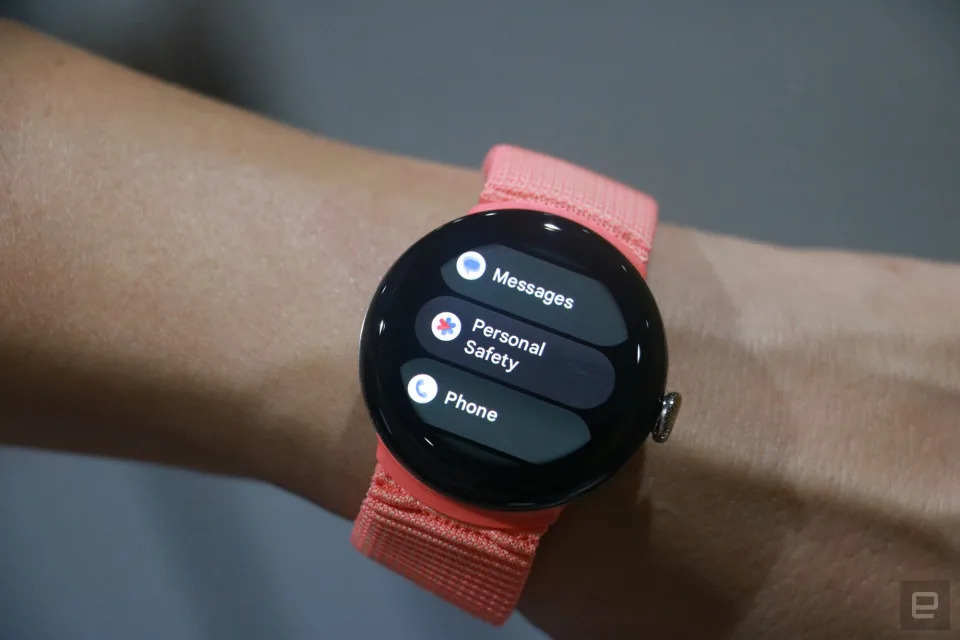
Google takes a similar approach—navigate to the Personal Safety app on the Pixel Watch 2 and select Safety Check. This enables you to set a timer for your desired duration. When the timer expires and you don’t confirm your well-being to the watch, Google will alert your predefined contacts and share your most recent or real-time location.
Safety Check appears to be a handy feature for occasional use, but what could genuinely enhance your daily interactions with the Pixel Watch 2 are updated Google apps such as Calendar and Gmail. Furthermore, the Google Assistant is gaining support for health and fitness queries, a change that bears a resemblance to a recent addition by Apple. With this, you can request real-time or historical stats without having to touch the screen. However, unlike Apple, the Pixel Watch 2’s assistant requests are not processed on the device itself, necessitating an internet connection.
Numerous changes are on the horizon for the Pixel Watch, and while some seem more impactful than others, the true significance of this year’s update will become clearer with a thorough review. If you’re already excited about the new features, you can pre-order the device or purchase it starting on October 12. The Pixel Watch 2 offers silver, black, and gold cases with various strap options, all of which come with six months of Fitbit Premium included.

